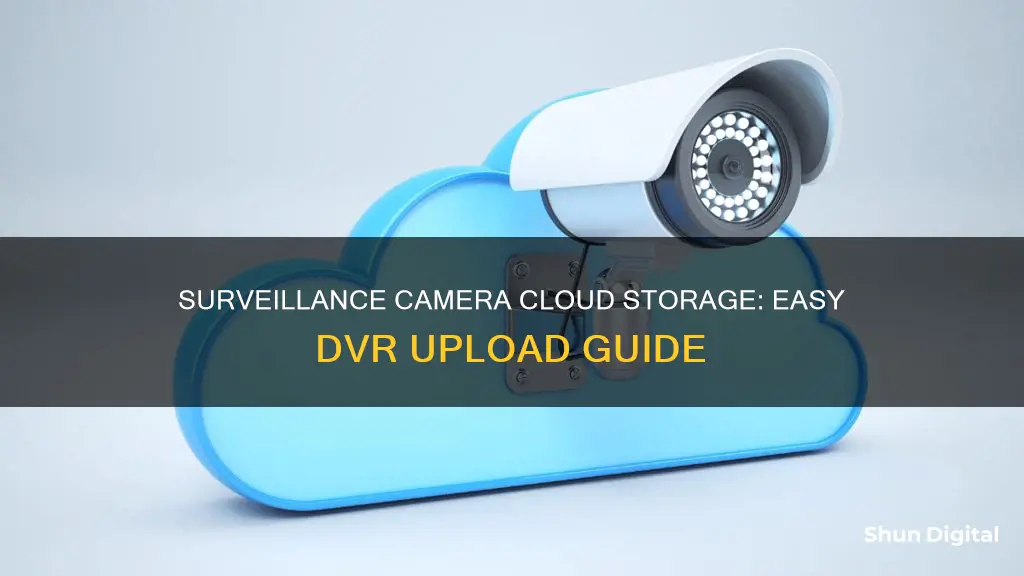
Cloud storage is an efficient and secure way to store your DVR surveillance camera footage. It is a simple process that involves choosing a cloud storage service, installing and configuring the relevant app, and setting up automatic uploads. This ensures that your footage is safely stored and easily accessible from anywhere. Cloud storage offers benefits such as remote viewing, multi-user permissions, and customizable live viewing. Additionally, it eliminates the need for complex on-site hardware and provides a single, secure location for all your media. By following the necessary steps, you can easily upload your DVR surveillance camera footage to the cloud and enjoy the advantages of modern cloud technology.
| Characteristics | Values |
|---|---|
| First Step | Choose a cloud storage service |
| Second Step | Install the cloud storage app |
| Third Step | Configure the app |
| Fourth Step | Set up automatic uploads |
| Fifth Step | Monitor your uploads |
| Cloud Storage Options | Amazon Web Services (AWS), Google Cloud Platform, and Microsoft Azure |
| Additional Features | Video analytics and facial recognition |
| Pros of Cloud Storage | Security, accessibility, and ease of use |
What You'll Learn

Select a cloud storage provider
When selecting a cloud storage provider, it is important to consider the specific needs and requirements of your surveillance system. Here are some key factors to keep in mind:
Data Storage Capacity
Cloud storage offers a flexible and scalable solution for surveillance camera systems. Unlike traditional on-site storage methods such as DVRs and NVRs, which have limited storage capacity, cloud storage allows you to easily increase or decrease your storage capacity as needed. This is especially beneficial for businesses that are expanding or have fluctuating storage demands. Consider the amount of data generated by your cameras, the resolution of the footage, and the retention period required for your industry to determine the necessary storage capacity.
Security and Protection
The security of your surveillance footage is of utmost importance. Cloud storage providers offer various security measures to protect your data, including single sign-on, password protection, and two-step verification, and encryption. Ensure that the cloud storage provider you choose has robust security protocols in place to safeguard your footage from unauthorized access, hacks, and data loss. Additionally, look for features like data encryption during transit to ensure the secure transmission of your camera feeds to the cloud.
Accessibility and Remote Viewing
One of the significant advantages of cloud storage is the ability to access your surveillance footage remotely. Look for a cloud storage provider that offers easy and secure remote viewing options. This will enable authorized users to access live and recorded footage from any location, using a web browser or a mobile app. This feature is particularly useful for businesses with multiple sites, as it allows for centralized monitoring and enhances operational flexibility. Ensure that the provider offers user access controls and permissions to manage who can view the footage.
Hardware Compatibility
Consider the compatibility of the cloud storage service with your existing surveillance cameras and hardware. Some cloud storage providers may have specific camera requirements or brand limitations. Ensure that your cameras are compatible with the cloud system or look for providers that offer a wide range of camera compatibility, including support for various brands and camera types (IP cameras, analog cameras, etc.). This will ensure that you can seamlessly connect your cameras to the cloud without the need for extensive hardware upgrades.
Cost Considerations
The cost of cloud storage can vary depending on several factors, including storage capacity, retention periods, and additional features. Evaluate the pricing plans offered by different providers and choose one that aligns with your budget and storage needs. Consider the long-term costs associated with cloud storage, especially if you anticipate increases in data volume or retention requirements over time. Additionally, look for providers that offer flexible payment options, such as monthly or annual plans, to suit your financial preferences.
Reliability and Performance
The reliability and performance of the cloud storage provider are crucial factors to consider. Ensure that the provider has a strong track record of uptime and minimal outages. Check their service-level agreements (SLAs) and guarantees regarding system availability and data recovery. Additionally, consider the bandwidth requirements for cloud storage. High-resolution camera feeds and large file sizes can consume significant bandwidth, so ensure your network infrastructure can support the data transmission without causing delays or performance issues.
Charging Your Nikon: A Quick Guide to Powering Up Your Camera 3700
You may want to see also

Install the cloud storage app
To install the cloud storage app for your DVR surveillance camera, you'll need to follow a few simple steps. Here's a detailed guide to help you through the process:
Step 1: Choose a Cloud Service Provider
First, you need to select a cloud service provider that is compatible with your DVR surveillance camera. Some popular options include Videoloft, Camcloud, and CameraFTP. Each provider offers different features and compatibility, so be sure to research which one best suits your needs.
Step 2: Check Compatibility
Before installing the cloud storage app, ensure that your DVR surveillance camera is compatible with the cloud service. Most providers will have a list of compatible camera brands and models on their website. Check this information to confirm that your camera will work with their cloud storage solution.
Step 3: Create an Account
Sign up for an account with your chosen cloud service provider. This usually involves providing your personal information, such as your name, email address, and creating a password. You may also need to select a subscription plan that suits your storage needs.
Step 4: Install the App
Download and install the cloud storage app provided by your chosen service. This app will allow you to manage your camera's connection to the cloud and access its footage. You can typically find the app on the provider's website or official app stores for iOS and Android devices.
Step 5: Configure Your Camera
Now, you'll need to configure your DVR surveillance camera to upload footage to the cloud. This process will vary depending on the cloud service and camera model. Refer to the instructions provided by your cloud service provider for detailed steps on how to set up your specific camera model.
Step 6: Test and Adjust Settings
Once you've installed the app and configured your camera, test the connection to ensure it's working properly. Access the live feed and playback options to verify that footage is being recorded and stored in the cloud. Adjust any settings as needed, such as recording schedules, motion detection, and alert configurations.
By following these steps, you'll be able to successfully install and set up the cloud storage app for your DVR surveillance camera. Remember to refer to the specific instructions provided by your chosen cloud service provider for detailed guidance throughout the process.
Focusing Thermal Cameras: Tips for Crisp Infrared Images
You may want to see also

Configure the app
Once you have chosen a cloud storage provider, you will need to install the app on your DVR system. This will allow you to upload your surveillance footage to the cloud.
After installing the app, you will need to configure it. This typically involves entering your login credentials and selecting the folders where you want to store your surveillance footage. For example, if you are using Google Drive, you will need to select the "Movies" folder to store your video recording files.
You may also need to set up an FTP or SFTP connection between your DVR system and the cloud storage provider. This will ensure that your footage is uploaded securely and reliably.
Additionally, you may need to configure the necessary settings to enable automatic uploads. This will ensure that your footage is automatically uploaded to the cloud as soon as it is recorded.
It is important to regularly monitor your cloud storage account to ensure that your footage is being uploaded correctly and that you have enough storage space. You may also need to implement retention policies to manage older footage automatically.
Camera Battery Radioactivity: What's the Truth?
You may want to see also

Set up automatic uploads
Setting up automatic uploads from your surveillance camera to the cloud is a straightforward process. Here is a step-by-step guide to help you get started:
Step 1: Choose a Cloud Service Provider
Firstly, you need to decide which cloud service provider you want to use. There are many options available, such as Videoloft, Google Drive, or Sync. Each service has its own features and benefits, so it's essential to research and choose one that suits your needs.
Step 2: Check Compatibility
Before setting up automatic uploads, ensure that your camera brand and model are compatible with the cloud service you've chosen. Some cloud services may have specific requirements or limitations, so it's important to verify compatibility to avoid any issues.
Step 3: Create an Account and Cloud Plan
Sign up for an account with your chosen cloud service provider. During this process, you'll likely need to select a cloud plan that outlines the amount of storage and any additional features you require.
Step 4: Install the Cloud Adapter
If you're using a service like Videoloft, you'll need to install their Cloud Adapter. This usually involves connecting the adapter to your network and power supply, and then following the setup instructions provided by the cloud service.
Step 5: Connect Your Cameras
Use the cloud service's app or website to connect your cameras to the cloud. This typically involves scanning for cameras on your network and then authenticating them with their respective usernames and passwords.
Step 6: Configure Upload Settings
Once your cameras are connected, you can configure the upload settings to enable automatic uploads. This may include selecting the upload size, choosing the upload location, and specifying whether you want to upload only via Wi-Fi or also using cellular data.
Step 7: Test and Verify
After setting up automatic uploads, it's important to test and verify that your system is working correctly. Check the live feed, ensure motion-activated events are being recorded, and make any necessary adjustments to the camera settings to fine-tune your setup.
By following these steps, you can efficiently set up automatic uploads from your surveillance camera to the cloud, ensuring that your footage is securely stored and easily accessible.
FLIR Cameras: Where Are They Manufactured?
You may want to see also

Monitor your uploads
To ensure your DVR surveillance footage is being uploaded to the cloud correctly, it is important to regularly monitor your cloud storage account. Here are some steps to help you monitor your uploads effectively:
- Regularly Check Your Cloud Storage Account: Log in to your cloud storage account and verify that your footage is being uploaded as expected. Check the upload status, file sizes, and the date and time of the uploads to ensure they align with your DVR recordings.
- Set Up Alerts and Notifications: Most cloud storage services offer alert and notification features. Set up alerts to notify you when new files are uploaded, or when there are any issues with the upload process. This helps you proactively monitor your uploads and address any problems promptly.
- Review Upload Schedules: Depending on your cloud storage provider and settings, you may have scheduled uploads set up. Review these schedules to ensure they align with your DVR recording schedule. Adjust the schedules as needed to make sure all your footage is being captured and uploaded correctly.
- Monitor Storage Space: Keep an eye on your cloud storage space to ensure it doesn't fill up unexpectedly. Check the file sizes of your uploads and the total storage used. If needed, consider upgrading your storage plan or deleting old or unnecessary footage to free up space.
- Test and Validate: Periodically test and validate your upload process to ensure its reliability. Upload a sample video clip or footage and check if it appears in your cloud storage account as expected. This helps identify any potential issues with the upload process or your cloud storage settings.
- Implement Retention Policies: To manage your cloud storage efficiently, consider implementing retention policies. These policies will automatically delete or archive old or unnecessary footage after a specified period. This helps free up storage space and reduces the time spent on manual deletion.
- Maintain Security: Ensure that your cloud storage account is secure by using strong passwords and enabling two-factor authentication, if available. Regularly update your login credentials and keep your account information confidential. This helps prevent unauthorized access to your surveillance footage.
By following these steps, you can effectively monitor your DVR surveillance camera uploads to the cloud, ensuring that your footage is securely stored and easily accessible whenever needed.
Customizing Your FO76 Camera: A Step-by-Step Mod Guide
You may want to see also







